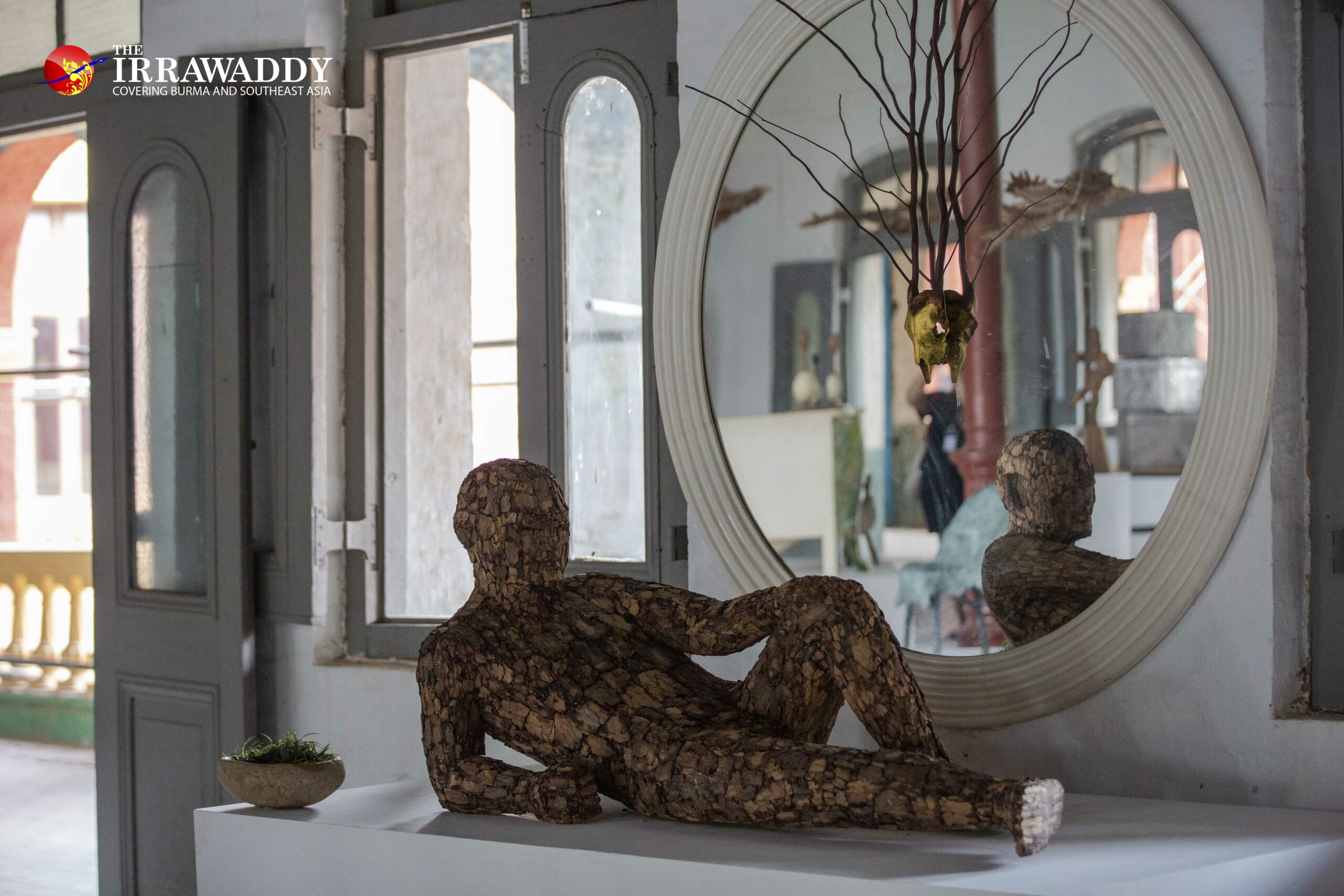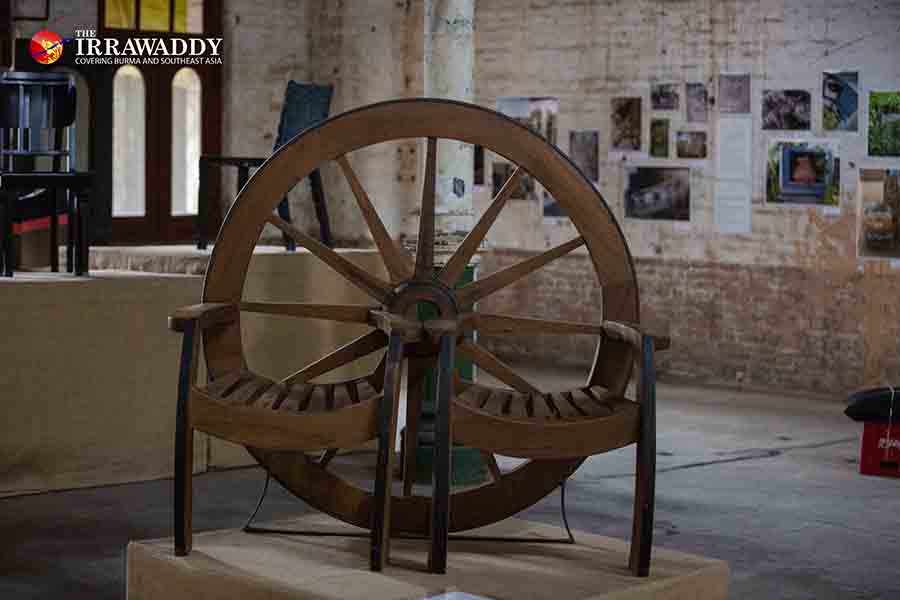The design exhibition “Pure Gold”, which has been hosted by a number of cities around the world, is now ongoing at Yangon’s Secretariat Office with the aim of educating local people about the virtues of transforming rubbish into useful and beautiful objects.
Organized by Goethe Institut Myanmar, the exhibition’s aim is to raise ecological awareness in Myanmar while giving a platform to local artists and NGOs involved in “upcycling” projects.
Previous events held at the Secretariat Office have occupied a few rooms, but the building’s operators opened up two extra rooms for the “Pure Gold” exhibition.
The exhibition occupies four main rooms, including two workshops and two exhibits. At the entrance of the exhibit, a big golden pangolin made from bamboo and recycled newspaper and a giant dragon’s head — the main highlight of the exhibition, made from bamboo sticks, re-used rice sacks, and plastic sheets — welcome the guests.

A body of a giant nagar (a mythical dragon) created by young artist Arker drapes the exhibition’s walls from room to room. It will be covered slowly everyday by visitors with small pieces of plastic, taken from huge sheets made out of old plastic bags.
The first room is a workshop room set up by Chu Chu, a non-profit organization that creates beautiful objects from recycled plastic, rubber and others in Yangon.
The workshop is full of handicrafts such as wallets, cardholders, belts, pencil holders, bottle holders, bags and decorative items that have found a new life after being rescued from the trash. The upcycled items include worn out tires, plastic bags, empty bottles, coffee mix sachets, cement bags and so on.

“All the items are really pretty; I never noticed before that we can turn those trash into useful and beautiful artistic object. I had to learn and see new ideas about possible designs or objects that can be made from trash,” said Sein Lei, 14, a student who visited the exhibition.
Visitors can join a do-it-yourself workshop and learn how to change trash into treasure. Some kids could be seen putting plastic pieces on the beautiful dragon’s as part of the giant nagar artwork.
The other room is a big exhibition produced by Bonjour Yangon. It focuses on creating traditional masterpieces and beautiful souvenirs, mainly from wood, bamboo and urban materials.

The objects are mainly artistic, decorative items. Some are genuine art installations made from betel nut, bamboo and beans. A human form made from branches seems very real, and the toys made from paper are so cute.
The next room is another workshop room but it’s for participating artists including Yadanar Win, Aung Myat Htay, Zun Ei, Ma Ei, Ko Latt, Ko Ye, Nge Nge, Kaung Myat Thu, Thiri Wai Maung, Pau San, Sen Sen, Suan Huai, Aye Lwin, Nang Hseng Noon, and Sai Puen Kur.
They introduce the concept of “upcycling” to visitors by making artworks in groups; some transform old shirts into trendy ones, some make slippers from old used copper cables and clothes.
“One of my friends works at Goethe Institute Myanmar and asked me to join this exhibition project. Personally, I had also wanted to join this kind of ecological awareness project that introduces ideas about upcycling and recycling,” said Ko Latt, a local visual artist and one of the participants of the exhibition.

He added that, “Our country has a huge amount of garbage and most of the people don’t have the knowledge to transform trash into useful things. So, people gain knowledge and ideas through this event. This kind of exhibition is really good and we need it.”
Most of the visitors are foreigners, but there were a few local people. He hoped more local visitors would show up, and said local people need to get more comfortable with the idea of going to exhibitions.
The last room is filled with 76 beautiful objects that were made from garbage by 53 designers from all over the globe, alongside works of Myanmar artists.
The objects are mainly furniture, waste paper baskets, and all kinds of chairs and tables. Some are real art pieces. Some are pure art, some are designed to be useable objects, which could be put to use anywhere.

Among my favorite objects from this room are “Raymond table” by Davie Amar. The table was made from old bleached, varnished and stained cut boards. It’s modern furniture and really stylish. Another one is an object made by the local artist Htein Lin. The “Dhamma Seat” was made by from an old cartwheel.
The last one is “Football carpet” by the artist Janina Stubler. The stylish and colorful carpet was made from old football covers. The other objects are also pretty.
“We don’t expect that we will resolve the problem of garbage. Of course, recycling is the only way—good recycling, systematic recycling—is the only way to deal with the huge amount of garbage,” said Franz Xaver Augustin, director of the Goethe-Institut Myanmar.
He added that, “What we can do here is create awareness about the problem of throwing away everything without thinking. If that is achieved, we will reach our goal and our intention.”

Objects made from waste products are already available in shops now in Myanmar and sell at a good price. They make good money, he said.
“So, if you are able to transform waste in the right way, and create something beautiful and useful, then you will find the market,” added Augustin.
The “Pure Gold” exhibition traveled from Hamburg, Germany to London, and then to Bangkok. Yangon is the fourth stop on its tour around the world. It runs until Jan. 6, open daily from 10.30 a.m. to 4.30 p.m. The exhibition is open to the public free-of-charge.

















